| Pubs As in
most Black Country towns the public house has been at
the centre of people's social lives for many
generations. The buildings often bring back fond
memories of days gone by, or old friends.
I have attempted to include a list (which is possibly
incomplete) of the towns past and present public houses.
If anyone can add to the list or make any corrections
please send
me an email.
|
Albert Street |
The Crown |
|
Holyhead Road |
The Britannia Inn |
|
Albert Street |
The Fox and Dogs |
|
Holyhead Road |
The Cross Keys |
|
Albert Street |
The London & North Western Hotel |
|
Holyhead Road |
The Dartmouth |
|
Alma Street |
The Village Inn |
|
Holyhead Road |
The Ocean House |
|
Alma Street |
The Vine |
|
Holyhead Road |
The Queen's Arms |
|
Bilston Road |
The Cottage Spring |
|
Holyhead Road |
The Railway Tavern |
|
Bilston Road |
The Cross Guns |
|
Holyhead Road |
The Station |
|
Birmingham Street |
The Acorn |
|
Holyhead Road |
The Stores |
|
Bridge Street |
Coach & Horses then the Coachmaker's
Arms |
|
Holyhead Road |
The Three Crowns |
|
Bridge Street |
The Fountain |
|
Holyhead Road |
The Three Swans |
|
Bridge Street |
The Hare & Hounds |
|
Hydes Road |
The Croft |
|
Bridge Street |
The Red Lion |
|
King Street |
The Royal Oak |
|
Bridge Street |
The Ship |
|
Leabrook Road |
The Boat Inn |
|
Bridge Street |
The White Horse |
|
Leabrook Road |
The Britannia Inn |
|
Bridge Street |
The White Swan |
|
Leabrook Road |
The Bush |
|
Brunswick Park Rd. |
The Isle of Man |
|
Leabrook Road |
The Golden Cups |
| Brunswick Park
Rd. |
The Queen's Head |
|
Leabrook Road |
The Jolly Colliers |
| Camp Street |
The Joiner's Arms |
|
Leabrook Road |
Lea Brook Tavern |
| Camp Street |
The Jolly Brewer |
|
Leabrook Road |
The Plough & Harrow |
| Camp Hill Lane |
The Bull's Head |
|
Leabrook Road |
The Railway Tavern |
| Church Hill |
The Rosehill Tavern |
|
Lower High
Street |
The Coach
& Horses |
| Church Street |
The Market House Tavern |
|
Lower High
Street |
The Duke
of York |
| Church Street |
The Woden Inn |
|
Lower High
Street |
The Nag's
Head |
| Cobden Street |
The Borough Arms |
|
Lower High
Street |
The Turk's Head |
| Cobden Street |
The Forge |
|
Market Place |
The Green
Dragon |
| Coronation Road |
The Windmill |
|
Market Place |
George &
Dragon |
| Crankhall Lane |
The Brunswick |
|
Market Place |
The Pig &
Trumpet.
Originally Old Golden Cross |
| Crankhall Lane |
The Canal Tavern |
|
Market Place |
The
Talbot Hotel |
| Crankhall Lane |
The Friar Park Inn |
|
Market Place |
The White
Lion |
| Cross Street |
The Smith's Arms |
|
Meeting Street |
The Jolly
Collier |
| Dale Street |
The White Lion |
|
Meeting Street |
The Old
Royal Oak |
|
Dale Street |
The Woodman |
|
Mill Street |
The
King's Hill Tavern |
|
Darlaston Road |
The Fortune of War |
|
New Street |
The
Noah's Ark |
|
Darlaston Road |
The King's Hill Tavern |
|
New Street |
The Why
Not |
|
Darlaston Road |
The Oddfellows |
|
Old Park Road |
The Black
Horse |
|
Darlaston Road |
The Old Barrel |
|
Oxford Street |
The
Foresters Arms |
|
Darlaston Road |
The Old Park Hotel |
|
Park Lane |
The Myvod
Inn |
|
Darlaston Road |
The Rose & Crown |
|
Portway Road |
The
Gladstone |
| Darlaston Road |
The Scots Arms |
|
Portway Road |
The
Grapes |
| Darlaston Road |
The Talbot |
|
Portway Road |
The
Nelson |
| Darlaston Road |
The Three Crowns |
|
Portway Road |
The Royal
Exchange |
| Dudley Street |
The Elephant & Castle |
|
Portway Road |
The
Spread Eagle |
| Dudley Street |
The Greyhound Inn |
|
Piercy Street |
The
Rising Sun |
| Dudley Street |
The Lea Brook Tavern |
|
Queen Street |
The
Queen's Head |
| Dudley Street |
The New Pack Horse |
|
Ridding Lane |
Dog &
Partridge |
| Dudley Street |
The Old Pack Horse |
|
Rowley View |
The
Highgate Arms |
| Dudley Street |
The Plough and Harrow |
|
Russell Street |
The Town
Hall |
| Earps Lane |
The Blue Ball |
|
St. Paul's Road |
The Forge
Arms |
| Elwell Street |
The Mazeppa |
|
Spring Head |
The
Standeford Hotel |
| Elwell Street |
The Museum Inn |
|
Terrace Street |
Oakeswell
End Tavern |
| Elwell Street |
The Royal Oak |
|
Trouse Lane |
The
Fortune of War |
| Elwell Street |
The Stores |
|
Trouse Lane |
The
Junction Inn |
| Franchise
Street |
The Cottage Spring |
|
Trouse Lane |
The
Rising Sun |
| Franchise
Street |
The Forge Tavern |
|
Union Street |
The Three
Tuns |
| Franchise
Street |
The Horse & Jockey |
|
Union Street |
The Rose
Inn |
| Friar Park Road |
The Coronation |
|
Upper High
Street |
The
George originally
The King's Head |
| Great Western
St. |
The Brunswick |
|
Upper High
Street |
The
Grapes |
| Great Western
St. |
The Railway |
|
Upper High
Street |
The Lamp
Inn originally
The Midland Vaults |
| Great Western
St. |
Great Western Hotel |
|
Upper High
Street |
The Royal
Exchange |
| Hall End |
The Old Blue Ball |
|
Vicarage Road |
The Rose
Hill Tavern |
|
High Bullen |
The Crown & Cushion |
|
Vicarage Road |
Ye Olde
Leathern Bottel |
| High Bullen |
The Elephant & Castle |
|
Victoria Street |
The
Prince Regent |
| High Bullen |
The Horse and Jockey |
|
Walsall Street |
The Bell |
| High Bullen |
The King's Arms |
|
Walsall St.
corner
of Windmill St. |
The
Castle Inn |
| High Bullen |
The Samson and Lion |
|
Walsall Street |
The Park
Inn |
| Holloway Bank |
The Fountain Inn |
|
Wood Green Road |
The
Cottage Inn |
| Holloway Bank |
The Globe Inn |
|
Wood Green Road |
The Horse
& Jockey |
| Holyhead Road |
The Anchor Inn |
|
Wood Green Road |
The Star
Inn |
| |
|
|
Wood Green Road |
The
Woodman |
|
The oldest pub in Wednesbury is Ye Olde Leathern
Bottel in Vicarage Road which is believed to date from
1510. The White Horse in Bridge Street used to be
one of the places where the magistrates met until 1846
when the Staffordshire Quarter Sessions built a
courtroom in Russell Street. The Wednesbury terminus of
the Birmingham trams was also known as the White Horse
because it was next to the pub.
Before the coming of modern public transport, in the
form of railways, trams and buses, people travelled from
town to town on the horse-drawn coaches that called at
coaching inns, where the horses could be changed,
passengers could be fed, or obtain overnight
accommodation. Coaching inns tended to be on, or near
the main thoroughfares, and were often the most
successful public houses of their day. The main road
through Wednesbury was the Holyhead Road, part of which
is Bridge Street, named after the bridge that crosses
the River Tame. One of the town's leading coaching inns,
the Red Lion Hotel stood at 39 Bridge Street.
It became a successful coaching inn after the
building of the Wednesbury section of the Holyhead Road
in 1826, and deprived the Turk's Head in Lower High
Street of much of its coaching traffic. Prior to the
building of the new road, when the inn was kept by
Elizabeth Houldcroft, it had no coach traffic at all. By
the 1830s when the landlord was Richard Davis,
passengers from the London to Liverpool coaches were
catered for, while the horses were being changed. In the
1840s the London to Holyhead Royal Mail Coach stopped
there, as did coaches to Bridgnorth, Shrewsbury and
Stoke-on-Trent.
Horse-drawn omnibuses also stopped at the inn,
including an hourly service to Birmingham, and services
to Wolverhampton, Willenhall, and Darlaston. In the late
1820s and 1830s Richard Davis held an annual ball at the
Red Lion which was well attended and attracted visitors
from as far afield as Shropshire and Warwickshire. In
the 1850s Edwin Richards became landlord, followed by
Thomas Mills in the early 1860s, and Joseph Robert
Madeley in the early 1890s. By this time the coaching
traffic had ended thanks to the railways, and the
frequent tram service. Madeley then advertised himself
as a cab and car proprietor.

The Horse and Jockey,
on the corner of Wood Green Road and Hobs
Road, was built in 1898 and designed by Wood
& Kendrick. It was Grade II listed on the
9th July, 2020, mainly because of its
ceramic bar counter, which is one of only 14
left in the UK. The painted bowling green
sign on the right refers to a bowling green
that was replaced by the car park in 1964. |
The Red Lion featured in what must have been the
town's first balloon flight. It was reported in the
edition of the Wednesbury Herald that appeared on 30th
January, 1898. The unsuccessful ascent, made in the
first quarter of the nineteenth century was remembered
in the article by an old man, who remembered seeing the
flight as a child. It was made by James Sadler
(1753-1828), the first English aeronaut.
A balloon ascent was advertised to take place from
the Red Lion and caused the greatest excitement, as such
an exhibition was considered far before the age when
"Rough-Mo," "Old Bonker" and others of their fraternity,
understood no class of amusements, beyond cock-fighting,
pigeon flying and bull-baiting. The three prominent
aeronauts were Sadler, Green, and Graham. It was Green
who ascended from the Green Park in London at the
Coronation of George IV for the first time with coal
gas. Sadler was subsequently killed I believe. Sadler
was the aeronaut to ascend from Wednesbury. As may be
supposed the excitement was intense, every prominent
position being crowded, while the balloon was clearly
visible in the process of inflation. The supply of gas
was, however, insufficient, and the aeronaut, in
announcing the fact, was met with hooting derision and
threats. He became alarmed for the safety of himself and
his machine, and decided at all hazards to risk the
ascent as the lesser evil. Getting into the car, he gave
orders to release the balloon; it seemed reluctant to
leave terra firma, but it rose sufficiently high to
clear the opposite houses in Bridge Street, and deposit
itself in The Mounts - fortunately without injury to
either the aeronaut or his balloon.
Even though the Red Lion had a fine bowling green,
trade suffered in the twentieth century. By the 1920s
the landlord was T. Wood. In the 1970s the pub closed,
and was demolished around 1980.
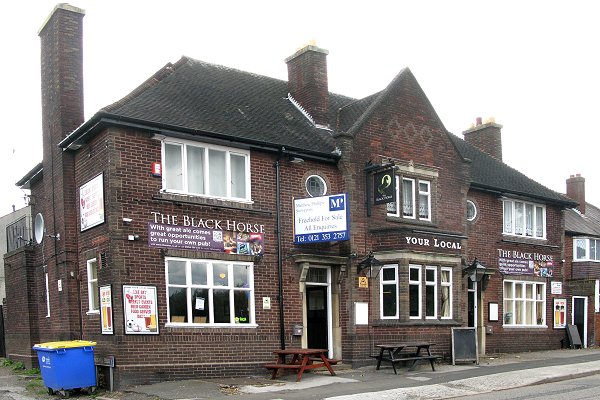
The Black Horse in Old Park Road.

An advert from 1917.
Many of the pubs got a lot of their customers from
nearby factories. The Plough & Harrow in Leabrook Road
is a good example. It would have greatly benefited
from being next door to the Patent Shaft.
| An advert from
1921. |
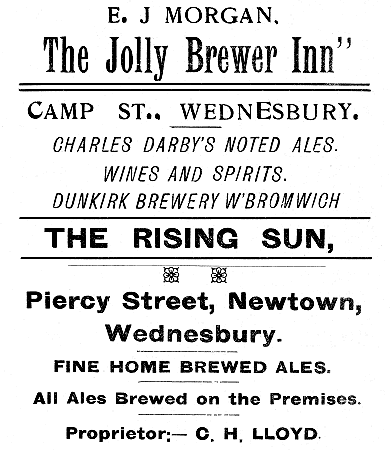 |
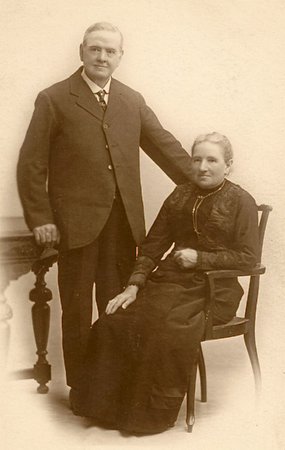 |
John Brown and his wife Charlotte. John
owned the
Bell Inn, Walsall Street in
the 1920s.
Courtesy of their great granddaughter,
Christine Paterson. |
| John Brown and his
chickens.
Courtesy of Christine Paterson. |
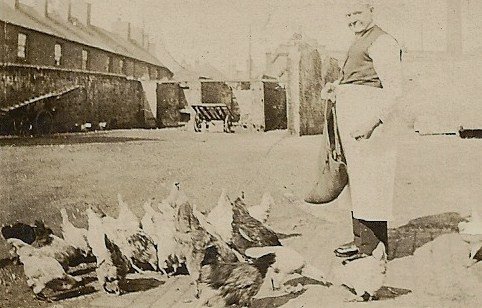 |
| The
Talbot Hotel The Talbot Hotel, 27 Market Place, on
the corner of Spring Head was built in 1879
to replace an old inn of the same name,
dating back to Elizabethan times. The old
pub featured in the colliers and miners
riots in August 1824 when a company of
regulars from the Staffordshire Yeomanry
were mounted in the yard to control the
rioters. At the time around 30,000 striking
colliers were assembled in the Turk's Head
field. They had been forcibly ordering the
miners who were still at work to join them.
Many colliers were detained and tried at the
Petty Sessions in the Turk's Head. Some were
committed to Stafford, from where twelve or
so were transported for life. |
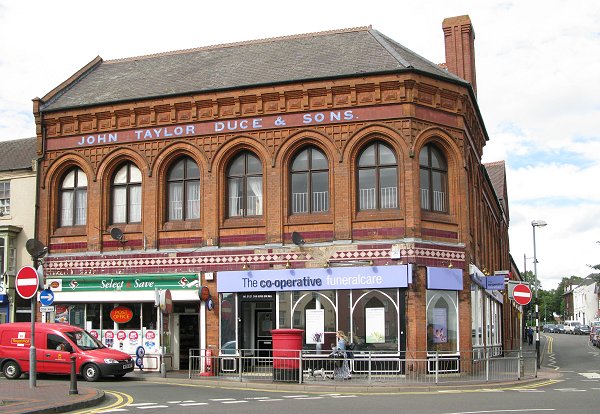 |
The Talbot Hotel,
as it is today. |
|

Another view of the old Talbot
Hotel. |
In 1818 Joseph Hateley was
landlord and a maltster. By 1828 Edward
Nightingale had taken over, and in 1851 the
licensee was John Guest. The new
Hotel was built by wine and spirit merchant
John Taylor Duce to house the pub and his
business.
The pub had an unexpected and interesting
tenant in the form of Sidney Webb the
undertaker, who started his business in the
cellar of the hotel. He founded the business
in 1894 and later moved to Willow Mews in
Meeting Street, before opening his establishment in Upper High Street. John Taylor Duce became a wealthy
man. In 1881 at the age of 56 he lived at Dunston
House, Dunston, which is on the A449, just over
halfway between Penkridge and Stafford. The late
18th century house is still there today, opposite
Dunston Parish Church. John lived with his wife
Harriett; daughters Ellen, Selina, and Charlotte;
sons William and James; and a housemaid, parlour
maid, scullery maid, and a cook. |
|

An advert from
1916. |
|
By the early years of the 20th century
the hotel had been taken over by Hickman & Pullen
Limited who brewed the range of 'Entire' ales
at their High Bullen brewery. |
|
On 8th July,
1918 the front part of the building in the
Market Place became Wednesbury Labour
Exchange when the Local Employments
Committee took out a twenty one year lease
on the property at an annual rent of £300.
The committee had the following members:
Chairman A. E. Pritchard, J.P.;
Vice-Chairman C. W. D. Joynson, J.P.;
Secretary Mr. A. S. Morgan; and Assistant
Secretary H. W. Bayliss.
The Manager of the Labour Exchange was Mr.
A. S. Morgan.
In 1927 Hickman & Pullen Limited decided
to sell the building. At the time the front
part facing the Market Place was occupied by
the Labour Exchange, and the part in Spring
Head had become the 'Standeford Bar' under
the management of Mr. O. T. Ayre. It
consisted of a bar-smoke room and a
children's room. In the cellar was a large
bottling stores with a bottle and bottle
washing department with brick bins, a
labelling room, a stacking room, and stores.
On the Spring Head side there were also two
large rooms which had been used as stores,
but were advertised in the sale as capital
assembly rooms. In the yard were stables, a
garage, and toilets. |
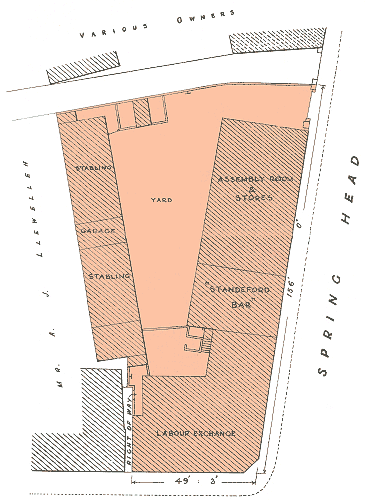 |
The building, which later became a
furniture shop, is now used as a post
office, an undertakers, and a hairdressers,
which is in Spring Head.
|
| The
King's Arms, High Bullen |
 |
Hickman & Pullen Limited also owned the King's Arms
pub on the High Bullen and the adjacent brewery and
maltings. In May 1927 it all went for sale at an
auction held at the Grand Hotel, Birmingham. At the
time the licensee was Mr. W. Beddow.
The pub consisted of a bar, front and rear smoke
rooms, a snug, an outdoor, and a public dining room
and kitchen. The first floor contained a large
assembly room, three bedrooms, a box room, a store,
and toilets.
There were two brick-paved cellars with brick
stillaging, a wine cellar, and a rolling way from
the yard. Outside at the back were toilets, a
pleasure green and a garden.
The six-quarter brewery consisted of beer, sugar,
and malt stores, fermenting, cooling, and malt
crushing rooms, a boiler house, and a cask washing
shed. Outside stood the cooperage, the bottle
washing room, a spirit stores, and a general store.
The ten-quarter maltings included a malt kiln, a
drying kiln, steeping and drying stores, a basement
store, and a stoke hole.
There was also a two-storey office building with a
general office and a manager's office. |
|

The Coachmaker's
Arms, Bridge Street. Courtesy of Brian
Groves and John Hellend. |
|
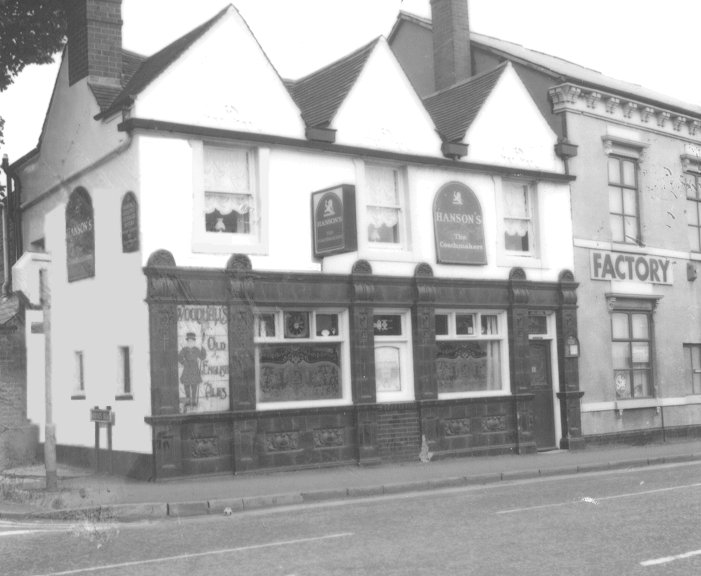
Another view of
the Coachmaker's Arms, Bridge Street. Courtesy of Brian
Groves and John Hellend. |
|
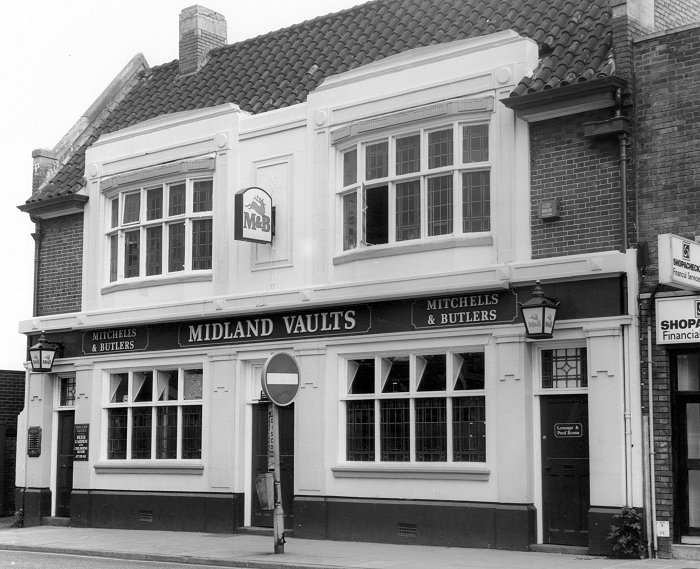
The Midland Vaults, Upper High Street. Courtesy of Brian
Groves and John Hellend. |
|
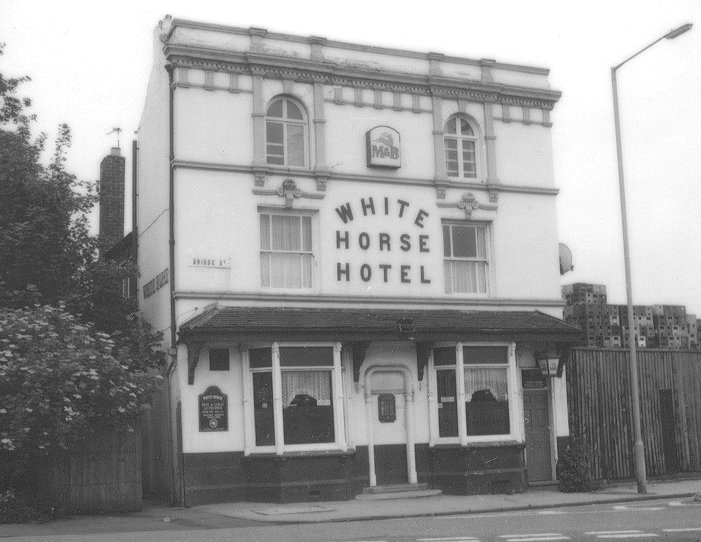
The White Horse
Bridge Street. Courtesy of Brian
Groves and John Hellend. |
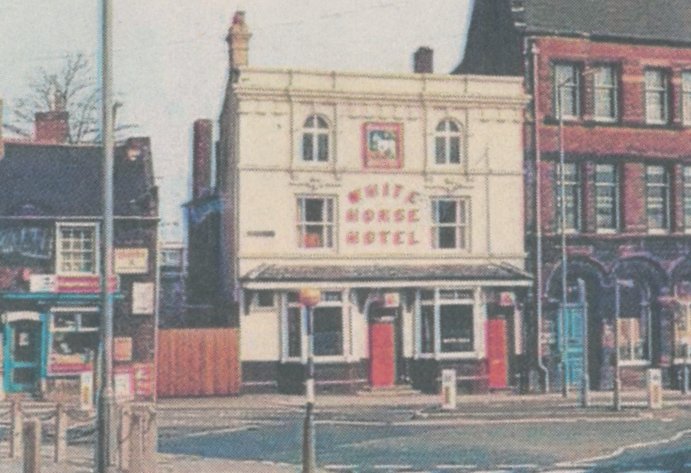
Another view of the White Horse,
which was close to the bus stop for West Bromwich and
Birmingham.
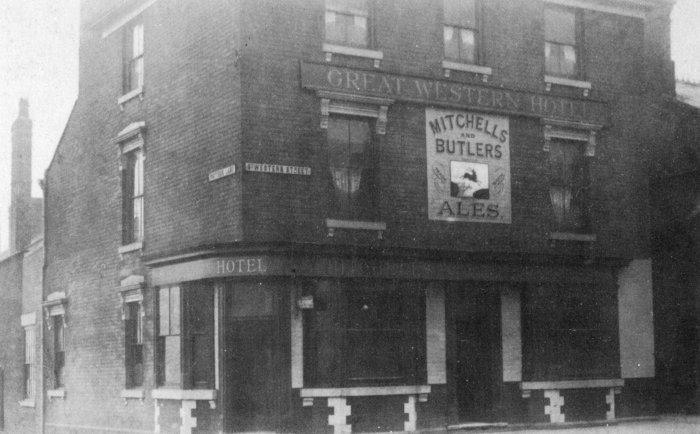
The Great Western Hotel. From an
old postcard.

The Anchor Inn in Holyhead Road,
now a nursery and the Livingston Academy.
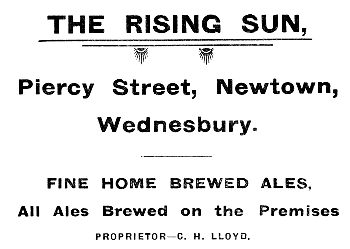 |
An advert from
1922. |
|
An
advert from 1922. |
 |
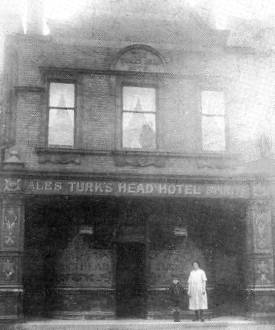
The Turk's Head in Lower High
Street.
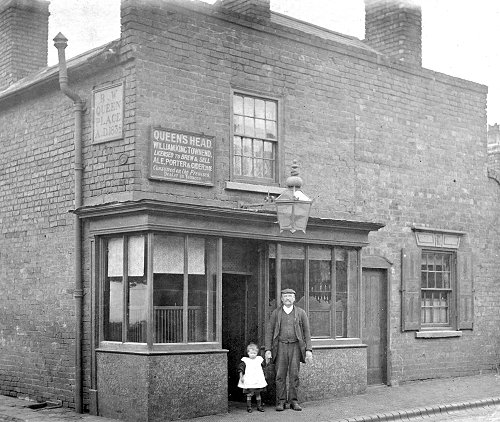
This lovely photograph
of the Queen's Head in Queen Street was
kindly sent by Bill Townend. It shows his
great grandfather William King Townend, with
his grandson of the same name. |
|
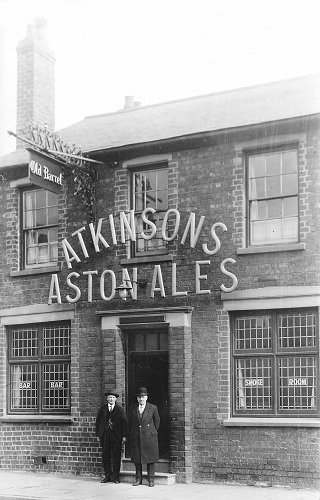
The Old Barrel. Courtesy
of David Adams. |
David Adams has kindly allowed me to include
his photographs of the Old Barrel which stood in
Darlaston Road, King's Hill. In 1921 the
licensee was A. Blakemore, who was followed by
David's grandfather George Golcher. This
photograph was taken in 1922 and shows George
Golcher on the left, with his friend Mr. Harvey.
George Golcher was licensee of the Old Barrel
for about twenty four years, until his death in 1947,
when it was taken over by his son, Alfred Adams,
who ran it for two years.
George was known as the landlord who never
called time. When drinking-up time came, he
indicated it by putting on his straw hat.
David Adams spent the first eighteen years of
his life at the the Old Barrel.
The pub had many sporting connections. Jimmy
Driscoll the boxer trained there, and it was
home to a pigeon flying club, and a cycling
club.
The Old Barrel stood in Darlaston Road, on
the corner of what is now Parklands Road, where
the flats now stand. |
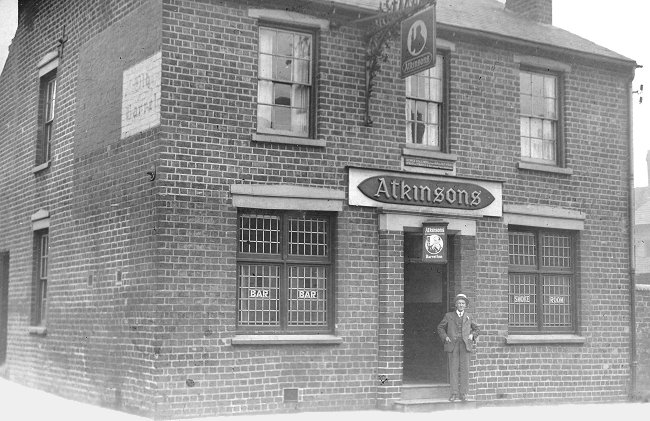
Another view of the
Old Barrel with George Golcher stood in the
doorway, wearing his straw hat. Courtesy of
David Adams. The photograph was taken by
David's father Alfred Adams. |
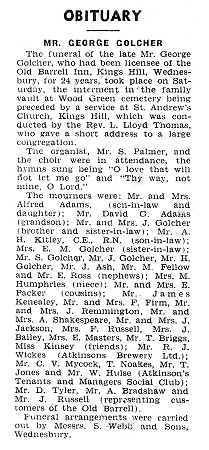 |
The photo on the
right, courtesy of David Adams, shows George
Golcher and his straw hat.
The obituary on the
left, also courtesy of David Adams, is dated
21st June, 1947. |
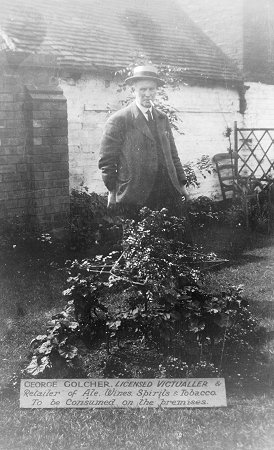 |
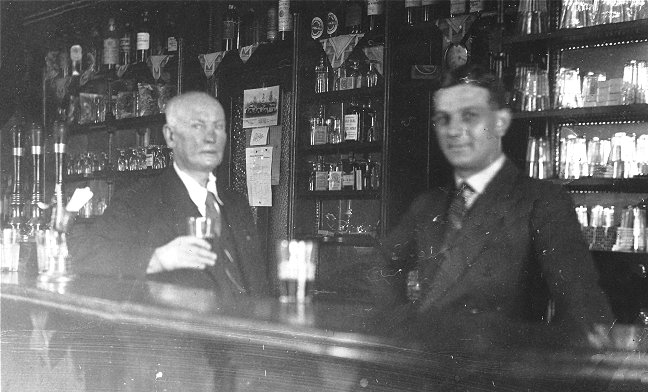
George Golcher behind the bar at
the Old Barrel. Courtesy of David Adams.
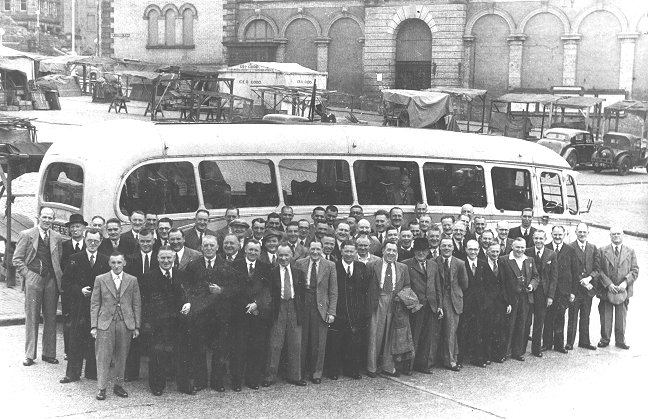
A trip from the Old Barrel to
Wolverhampton. Courtesy of David Adams.
| I have to thank Keiron Parton for
sending the three lovely photographs below.
The first is of the Cottage Spring in
Franchise Street, the second is of the
landlord, William Whitehall, and the third
is of his second wife, Sarah, who sadly died
in 1918. The Whitehall family ran the
Cottage Spring from 1908, when it was
acquired by William Whitehall. It remained
in the family until 1965 when it was sold to
Holden's Brewery. At one time it had its own
brewery.
William was born in 1858 and died in 1938.
His estate and business was left in trust
for the benefit of his remaining family. He
had previously been a Gun Lock Forger. He
had a large family, with 11 children from
his first marriage, and 3 from his second
marriage, this being to Sarah Wakefield of
Oldbury.
A framed copy of the photograph below, was
presented to Holden's, at the Cottage
Spring, on Sept 8th, 2013 by Sheila
Whitehall-Martin during her visit from
Australia. Fourteen family members were
present, including grandchildren, great
grandchildren, and great, great
grandchildren. |
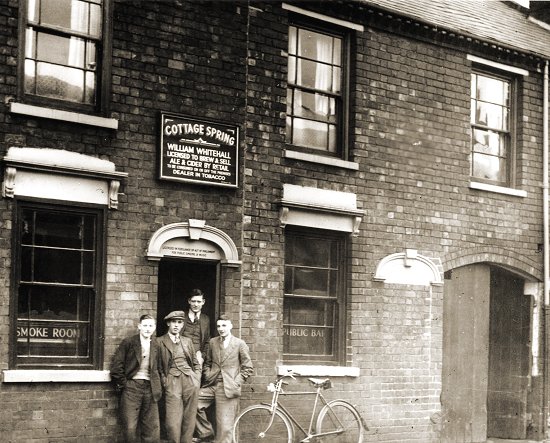
The Cottage Spring in
about 1934. Left to right: Tommy Brookes
jnr. (Leslie Whitehall's cousin), Jack
Ward, Leslie Whitehall (Williams’ youngest
son), and Bernard Mooney. |
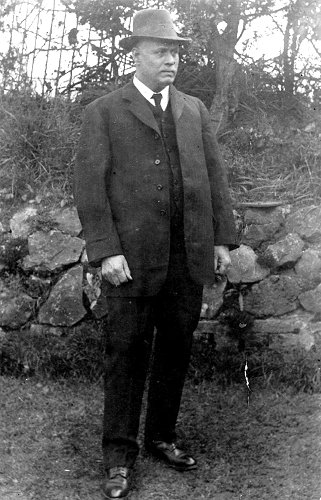 |
|
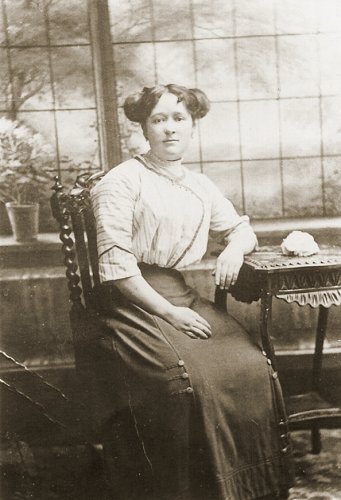 |
|
William
Whitehall in the Cottage Spring
garden. |
|
William's
second wife, Sarah Wakefield. |
|
| The Old Blue Ball
in Hall End, on the side of Church Hill,
dates back to the late 18th century. The
first licensee was Jonah Spittle in 1786.
From 1860 to 1868, and
again in 1870 the licensee was Joseph
Brittain who issued the token, seen below. |
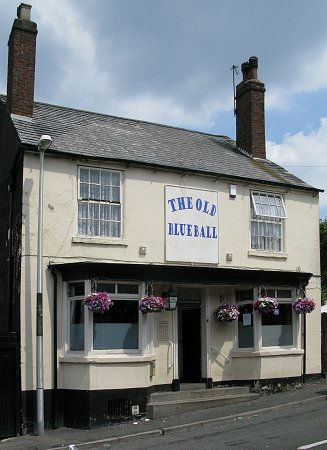 |
|

Courtesy of Jean
Brittain. |
The Brittain family are listed in the 1861
census as follows:
Joseph Brittain age 49, publican.
Ann Brittain age 48, wife.
(maiden name Whitehouse)
John Brittain age 23, gas tube maker.
William Brittain, age 21, brewer.
Ann Maria Brittain, age 14, scholar.
Joseph Brittain, age 12, scholar.
James Brittain, age 10, scholar.
Ellen Spooner, age 20, general servant. |
| The Brittain family left Wednesbury and
moved to Scotland in the late 1800s. On the
right is Ann Maria Brittain, born in
Wednesbury around 1847. The photographer was
J. Hopwood, Market Place, Wednesbury. The
Brittain family kept other Wednesbury pubs.
William was licensee of the Old Royal Oak
Inn, in Meeting Street from 1849 to 1870.
His son Thomas kept the Cross Guns in
Bilston Road from 1860 to 1873. Another
member of the family, Henry Brittain became
an engineer and went to Spain, where he
became a bull fighter. |
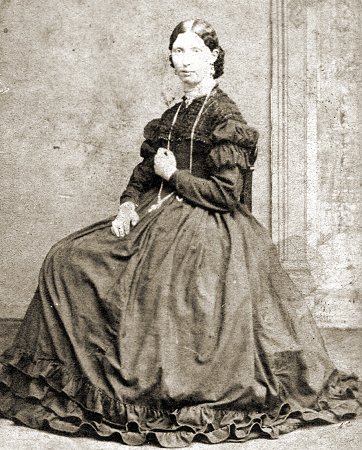
Courtesy of Jean
Brittain. |
|